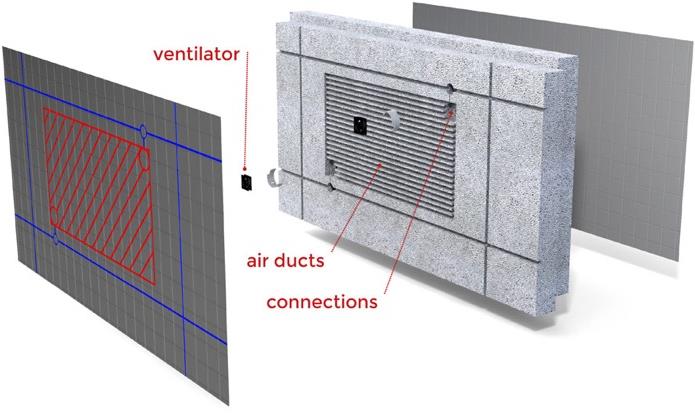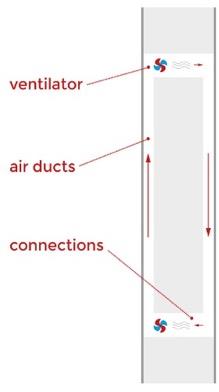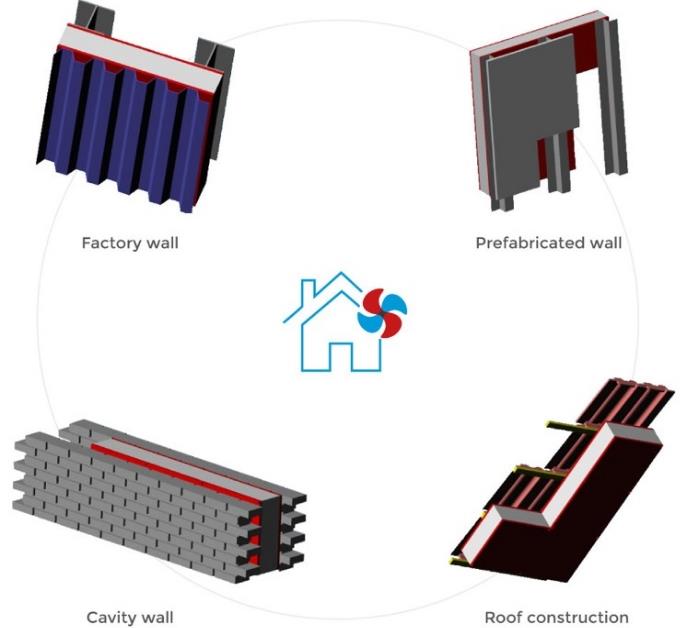Brief Concept Description
Active Insulation is a building envelope system developed by the Dutch start-up “Active Insulation Systems BV” whose insulation function can be switched on and off. During normal operation, the building skin acts as a regular thermal barrier between indoor and outdoor. In some occasions, however, the heat transfer can be encouraged instead of blocked to exploit the external climatic conditions to reduce the energy load of the building and improve the comfort of the occupants. During summer nights, for example, it is possible to take advantage of the lower outdoor air temperature to regulate the indoor temperature without active cooling. Similarly, the thermal insulation can be bypassed during sunny days in winter, to make better use of solar gains and reduce the space heating demand.
The current prototype is based on already proven technologies and functions as a closed-loop air-to-air heat exchanger as shown in Figure 66. Manifold channels are inscribed in the insulation material and small embedded fans (~0.5 W/m2) allow the occupant or the building management system to either create a stagnant air cavity, or to short-circuit the insulation layer by means of the airflow. Initial calculations indicate a heat exchange rate of ~15 W/m2 at a temperature difference of 10 C (on state). Hot-box simulations show a change of Rs value from 5.4 m2K/W (off state) to 0.6 m2K/W (on state), which can be further tuned depending on the host construction. Full-scale experimental studies and dynamic building performance simulations are currently being carried out.

Figure 66. Schematic drawing of Active Insulation.
Architectural and Technological Integration into the Envelope
Active Insulation is a standalone system (no air/water channels are entering or leaving the panel, Figure 67) that takes an existing insulation slab as its starting point. It is therefore fully compatible with existing ways of working in the construction industry.
Since the slabs are fitted with regular mounting points that do not interfere with the heat exchanging capability of Active Insulation, it can be integrated in many different construction types, such as masonry walls, prefabricated sandwich wall elements, steel frame panels or (pitched) roof systems (Figure 68).

Figure 67. Vertical section of a wall integrating Active Insulation. The system works as a closed loop heat exchanger with no exchange of air or water with indoor and outdoor environments.

Figure 68. Different applications of Active insulation in a variety of construction typologies.
Integration into the Building: System and Comfort
The fans integrated in the Active Insulation panels need a small amount of electric power to operate (~0.5 W/m2), which can be supplied through a wired connection or by means of autonomous PV systems with battery storage.
To maximize the benefits of Active Insulation, it is important that the operation of the system is well coordinated. This is a challenging task that may need different approaches for different orientations and depends on the (expected) occupancy of the building. The development of advanced control strategies and coupling with the building management system are therefore necessary conditions for a successful application of Active Insulation.